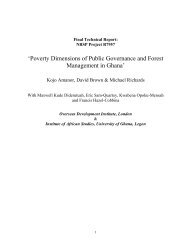Zimbabwe - Overseas Development Institute
Zimbabwe - Overseas Development Institute
Zimbabwe - Overseas Development Institute
You also want an ePaper? Increase the reach of your titles
YUMPU automatically turns print PDFs into web optimized ePapers that Google loves.
paper and packaging (1%); f e r t i l i z e r s and crop chemicals (54%),<br />
machinery (11%) and transport equipment (3%)iz2_<br />
Table 15.<br />
The Supply of Material Inputs To The Agricultural Sector<br />
1965 1975 1981/82<br />
Percent of Inputs provided<br />
by the Manufacturing Sector' 42 43 48<br />
Percent of Inputs Directly<br />
imported^ 9 7.5 10.4<br />
Inputs from Manufacturing<br />
to Agriculture as a<br />
percentage of total 3 6 7<br />
Manufacturing Output<br />
Notes: 1. The data for 1981/82 do not refer to capital purchases<br />
by the Agricultural Sector.<br />
2. The data in this row are broadly consistent with those<br />
of Muir for the period 1966 to 1979.<br />
Source: as for Table 14 and Muir (1981).<br />
The data on trends i n the r e l a t i v e shares of inputs sourced<br />
from imports and domestic i n d u s t r y are of l i m i t e d value because<br />
they capture only the d i r e c t and f i n a l t r a n s a c t i o n s , thus f a i l i n g<br />
to encompass the i n d i r e c t import component of domestically<br />
manufactured products. For instance i n the case of crop chemic<br />
a l s , almost a l l of the d o m e s t i c a l l y "manufactured" products<br />
c o n s i s t of simple formulation and packaging of imports, t h e i r<br />
import content being w e l l i n excess of 70% of t h e i r domestic<br />
s e l l i n g p r i c e . A more complete (although s t i l l l e s s than f u l l y<br />
accurate) p i c t u r e of t h i s aspect of a g r o - i n d u s t r i a l linkages can<br />
be obtained by l o o k i n g i n more d e t a i l at the supply of and demand<br />
f o r the key m a t e r i a l inputs required by the a g r i c u l t u r a l sector.<br />
These would include the f o l l o w i n g : f e r t i l i z e r s , crop chemicals,<br />
a g r i c u l t u r a l t o o l s and implements i n c l u d i n g t r a c t o r s and packagi<br />
n g m a t e r i a l s .<br />
Table 16 shows the t o t a l m a t e r i a l input purchases made by<br />
the a g r i c u l t u r a l sector i n 1984 sub-divided i n t o the commercial<br />
and other ( l a r g e l y communal) s u b - d i v i s i o n s of a g r i c u l t u r e . In<br />
terms of value, f e r t i l i z e r s and stockfeeds dominate t o t a l<br />
m a t e r i a l supply purchases, accounting f o r 85% of t o t a l m a t e r i a l<br />
inputs. Sub-dividing a g r i c u l t u r e i n t o two, however, produces<br />
some marked v a r i a t i o n s . The commercial sector purchased 83% of<br />
a l l input purchases i n 1984, the remainder j u s t 17%. Although<br />
t h i s d i f f e r e n c e i s c l e a r l y very great, i t has narrowed considerably,<br />
e s p e c i a l l y since Independence; f o r instance i n 1976,
















